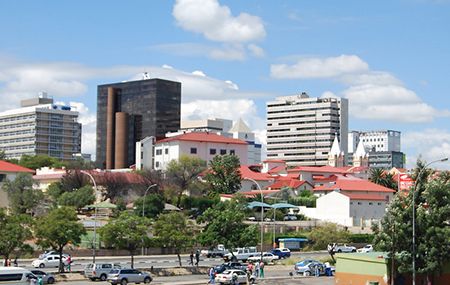
Compare the prices of all rental car companies
Subscribe for exclusive offers and deals!
4.2 / 5
4.2 / 5
Namibia is a vast and diverse country, with many attractions to explore. Renting a car is the best way to get around and see all the sights. With a car, you have the freedom to go wherever you want, whenever you want.
Renting a car in Namibia is also incredibly convenient. You can avoid public transport, which can be unreliable, and you can easily travel to remote areas. Plus, with a variety of car rental companies to choose from, you can find the perfect car to suit your budget and needs.

Other cities worth mentioning include the coastal town of Luderitz, the historic town of Okahandja, the German-influenced town of Otjiwarongo, and the colonial town of Grootfontein.
Car rental prices in Namibia vary depending on the type of car, time of year, and duration of rental. Generally, rates for car rental in Namibia are quite reasonable. For example, a mid-size car can cost around $30-50 per day, depending on the season and rental duration. Smaller cars can cost around $20-30 per day, and larger cars can cost up to $100 per day. Additionally, some rental companies may offer discounts for longer rentals.
When renting a car in Namibia, it is important to consider the type of vehicle that best suits your needs. For instance, if you are travelling through rugged terrain, a 4WD vehicle may be the best option. Additionally, some rental companies may offer additional services, such as GPS navigation, insurance, and child safety seats, which can add to the cost of the rental.
Finally, it is important to read the terms and conditions of the rental agreement before signing. This will ensure that you are aware of any additional fees or charges that may be associated with the rental. Additionally, it is important to ensure that you have the necessary documents and valid driver's license before renting a car in Namibia.
By following these simple tips, you can save money on your car rental in Namibia and get the best deal for your budget.
Driving in Namibia is generally safe and pleasant, with good quality roads and sensible speed limits. All drivers must have a valid driver's license, and all passengers must wear seatbelts. It is also important to note that it is illegal to drive under the influence of alcohol.
The following questions and answers are a selection of the most popular questions for Namibia. If you do not find the answer to your question, have a look at the Frequently Asked Questions page or contact us.
Namibia offers a wide variety of parking options for visitors. Depending on where you are visiting, there are a variety of parking facilities available. In the cities, many of the larger malls and shopping centers offer free parking, as well as paid parking in designated areas. In Windhoek, there are also several large parking garages located throughout the city, as well as a few smaller ones. In the smaller towns, there are usually a few public parking lots, as well as some private parking lots that can be used for a fee. In the more rural areas, there are usually limited parking options, so it is best to plan ahead and know where you can park before you arrive.
Yes, there are toll roads in Namibia. The toll roads in Namibia are operated by the Namibian National Road Fund Agency (NNRFA). The tolls are used to help fund road maintenance and construction projects throughout the country. The tolls are collected at specific toll plazas along the road and can be paid in cash or with a credit card. The amount of the toll varies depending on the type of vehicle, the number of axles, and the distance travelled. Drivers can also purchase a toll card that can be used to pay the tolls at any toll plaza in the country.
In Namibia, drivers are required to drive on the left side of the road.
The currency in Namibia is the Namibian Dollar (NAD).
The time zone in Namibia is Central African Time (CAT). This time zone is two hours ahead of Coordinated Universal Time (UTC+2). This time zone is used throughout the year, as Namibia does not observe Daylight Saving Time.
The official language of Namibia is English. English is the language of instruction in schools and is used in government and business. However, the majority of the population speaks various indigenous languages, including Afrikaans, Oshiwambo, Herero, Nama, Damara, Kavango, and others. English is also widely spoken in urban areas.
[EST] Mon - Fri: 03:00 - 16:00 Sat - Sun : 03:00 - 11:00
[GMT] Mon - Fri: 08:00 - 16:00 Sat - Sun : 08:00 - 16:00
Mon - Fri
Sat - Sun
03:00 - 16:00
08:00 - 16:00
[EST]
[GMT]
03:00 - 11:00
03:00 - 16:00